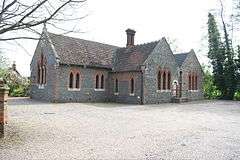Hoxne
| Hoxne | |
 Village Hall, Hoxne |
|
 Hoxne |
|
| Population | 889 (2011)[1] |
|---|---|
| District | Mid Suffolk |
| Shire county | Suffolk |
| Region | East |
| Country | England |
| Sovereign state | United Kingdom |
| Post town | EYE |
| Postcode district | IP21 |
| EU Parliament | East of England |
Coordinates: 52°21′N 1°12′E / 52.35°N 1.2°E
Hoxne /ˈhɒksən/ is an anciently-established village in the Mid Suffolk district of Suffolk, England, about five miles (8 km) east-southeast of Diss, Norfolk and 1⁄2 mile (800 m) south of the River Waveney. The parish is irregularly shaped, covering the villages of Hoxne, Cross Street and Heckfield Green, with a 'tongue' extending southwards to take in part of the former RAF Horham airfield.
In geology, Hoxne gives its name to the Hoxnian Stage, a British regional subdivision of the Pleistocene Epoch.
Overview
The area around the village is of remarkable archaeological importance, as the find-spot of the Hoxne Hoard of Roman treasure, very early finds of handaxes[2] and as the type site for the Hoxnian Stage ("Hoxnian Interglacial").
John Frere (1740-1807) was the first person to recognise the flint hand tools found deep in a clay pit at Hoxne as being man-made. His letter to the Society of Antiquaries, read on 22 June 1797 and published in the Society's journal Archaeologia in 1800, argued for the antiquity of these handaxes as "even beyond the present world", in a period now recognised as belonging to the Lower Paleolithic Age. Frere argued that these "weapons" were coincident with nearby extinct elephant fossils, in strata at the site of what is now known to be a Middle Pleistocene lake formed during the Great Interglacial geological warming period in Europe. Accordingly, in Britain that entire period is called "Hoxnian", signifying its identification there, based on evidence from undisturbed layers of pollens from plants and trees found at Frere's site in the 1950s (notably by Richard Gilbert West), which established the cycle of warming and cooling and defined the stages of the Great Interglacial.[3] Teams headed by the University of Chicago made extensive excavations at Frere's site for five years between 1971 and 1978.[4] They confirmed the date of the handaxes as ca 400,000 years BP, coincident with the Swanscombe finds, which, unlike the Hoxne, include human remains. Subsequent research by the Ancient Human Occupation of Britain team has confirmed the presence of these ancestors of the Neanderthals as occurring towards the terminal, cooling phase of the Interglacial period, which, according to Chris Stringer, "came to an end,...taking with it the lush river valleys, forests and grasslands on which the herds of horses and deer, and their hunters, relied. Ice sheets returned...to the north-west of Europe...and a new pattern of episodic occupation was set in motion", lasting over three-hundred thousand years.[5]
The Hoxne Hoard (pron.: /ˈhɒksən/ hok-sən) is the largest hoard of late Roman silver and gold discovered in Britain, and the largest collection of gold and silver coins of the fourth and fifth century found anywhere within the Roman Empire. Only fourteen years after the last dig by the U. Chicago team, on the same farm, only a few hundred meters south along the road, the Hoxne Hoard was discovered by a metal detectorist on 16 November 1992. The Hoard consists of 14,865 Roman gold, silver and bronze coins from the late fourth and early fifth centuries, and approximately 200 items of silver tableware and gold jewelry.[4] These objects are now in the British Museum in London, where the most important pieces and a selection of the rest are on permanent display. In 1993, the Treasure Valuation Committee valued the hoard at £1.75 million (today £2.66 million).
The village is also home to a 15th Century, Grade II listed lodge, formerly known as Bishops Lodge, built in 1480 by the Bishop of Norwich. It is today a popular pub, The Swan.
Legend
It is said that Saint Edmund, King of East Anglia, hid under the bridge known in those times as Gold Bridge to elude the pursuing Danes. A newly married couple saw the king's gold spurs and gave his location away to his enemies. According to the legend, Saint Edmund put a curse on all couples who cross the bridge on their way to get married.[6]
See also
References
| Wikimedia Commons has media related to Hoxne. |
- ↑ "Civil Parish population 2011". Neighbourhood Statistics. Office for National Statistics. Retrieved 19 August 2016.
- ↑ Frere, John:
 "Account of Flint Weapons Discovered at Hoxne in Suffolk"., in Archaeologia, v. 13 (London, 1800): 204-205
"Account of Flint Weapons Discovered at Hoxne in Suffolk"., in Archaeologia, v. 13 (London, 1800): 204-205 - ↑ Chris Stringer, Homo Britannicus: The Incredible Story of Human Life in Britain (London: 2006)
- ↑ Ronald Singer et al., The Lower Paleolithic Site at Hoxne, England (Chicago: The University of Chicago Press, 1993).
- ↑ Stringer, Homo Britannicus, pp. 90f.
- ↑ Anthony D. Hippisley Coxe, Haunted Britain, pg. 105, McGraw-Hill Book Company, New York 1973
Bibliography
- Govier, Stephen (2006). The Illustrated History and Antiquities of Hoxne.
- Frere, John (1800).
 Account of Flint Weapons Discovered at Hoxne in Suffolk.
Account of Flint Weapons Discovered at Hoxne in Suffolk. - Bishop, W.E. (1833). Views of Churches in the Hoxne Hundred.
- Rutherford, Betty (1973). A Wheelwright of Hoxne.
- Coleman, Nora. People Poverty and Protest.
- Evans, Margaret C. St Edmund and Hoxne. Stephen (illustrator), Govier.
- Govier, Stephen (2007). An Illustrated History and Guide to Diss, Norfolk.
External links
- Hoxne village website
- St. Peter and St. Paul Church
- Hoxne village hall
- Hoxne Mill
- Hoxne hoard of Roman artifacts
- Hoxne site of the Lower Paleolithic
- Hoxne handaxe
- Hoxne claim to martyrdom site of Saint Edmund